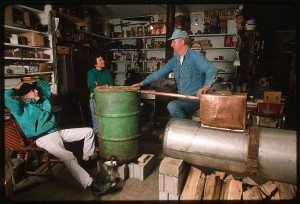By Richard Thomas
The presence of legal moonshine on store shelves and the popularity of programs like Moonshiners have given people an interest in this particularly juicy bit of American culture, on both the legal and illegal sides of the coin. As a result, new myths surrounding moonshine have arisen, while old myths are back in circulation. Here are five myths, some with a kernel of truth and others with none at all.
1. Moonshine Must Be Illegal To Be Moonshine: In the minds of many, the word “illicit” is inseparable from moonshine, and purists insist that the legal clear stuff appearing on store shelves today can’t be called moonshine precisely because it is legal, whatever its provenance. Adding strength are the many dictionary definitions backing up that interpretation. People are entitled to their opinions, of course, but the problem with this one is that it’s not entirely accurate.
In 1802, Thomas Jefferson abolished Alexander Hamilton’s hated whiskey tax, and excise taxes on spirituous liquors were not reintroduced until the Civil War. Thus, for the first half of the 19th Century many who had been making illicit, tax-free moonshine kept on doing what they hand been doing before, and calling their liquor what they had called it before too, legal or no. It’s therefore nothing new in America for moonshine to be used to describe a style of whiskey-making, rather than to its legal status.
2. Drinking Moonshine Will Blind You, Maybe Kill You: Stories of Americans going blind or even being poisoned to death from drinking moonshine date mostly to Prohibition, when all manner of inexperienced crooks got into the illicit distillation business. Being serious criminals (i.e. criminals beyond being bootleggers), they didn’t care about the quality of their liquor, so they took no care to eliminate toxic methanol from their products.
Serious ‘shiners who were in the business before and continued in it afterward weren’t like that, and cut the concentrated, methanol-bearing foreshot from their distillates as standard practice.
In fact, the worst booze poisoner in American history was the U.S. Government, which ordered the poisoning of industrial alcohol to prevent people from consuming it during Prohibition. This step is estimated to have slain at least 10,000 people, and maimed countless more.
3. Making Moonshine At Home Is Now Legal: Using a still to make alcohol for any purpose without the proper permits and licenses is illegal under Federal law, as well as local law in almost all states.
4. You Can Run Your Car On Moonshine: Maybe if it is coming straight from the still and made to an unusually high proof, but not otherwise. Driving your car on a tank full of alcohol requires that alcohol be a minimum of 150 proof (75% abv), and that is if you don’t mind a good bit of sputtering. To be an effective substitute for gasoline, the alcohol needs to be the 170 proof, E85 stuff sometimes sold at the pump (85% abv). Legal or illegal, moonshine is rarely bottled at higher than 120 proof (60% abv), and usually much lower.
So, if you pour moonshine from the bottle or jug straight into your gas tank, be prepared to call a tow truck for a trip to the mechanic.
5. Moonshine Is Synonymous With Corn Whiskey: Corn whiskey is defined by law as having a mashbill of 80% corn or greater, and may or may not be aged in barrels. By contrast, the common definition of moonshine calls for no barrel aging whatsoever, and while some of it is corn whiskey, some of it is not. The now-famous Prohibition era Templeton rye, for example, was essentially a rye-spiked rum. Even in the South, seat of corn whiskey cum moonshine, some recipes are sugar-spiked corn whiskey or corn-spiked rum, and in Northern states the use of fruit in making illegal, utterly not-whiskey moonshine was not unusual.
 The Whiskey Reviewer A World of Whiskey, Poured Every Weekday
The Whiskey Reviewer A World of Whiskey, Poured Every Weekday

